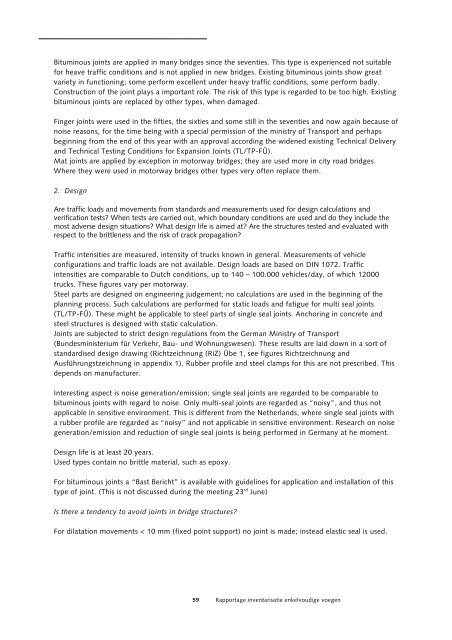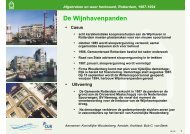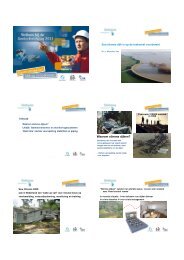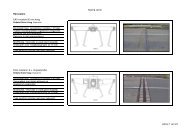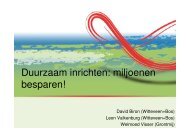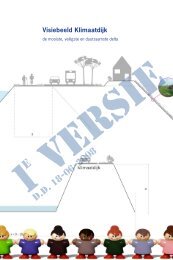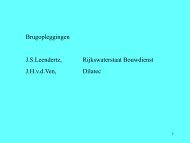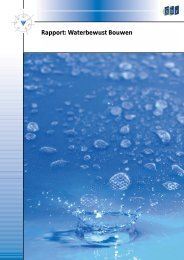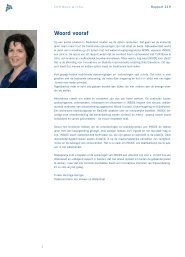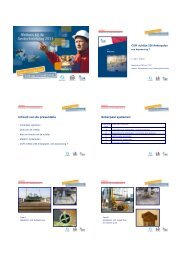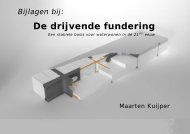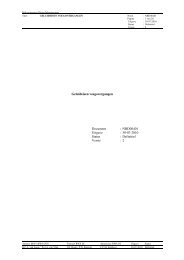Rapportage inventarisatie enkelvoudige voegen - Curnet
Rapportage inventarisatie enkelvoudige voegen - Curnet
Rapportage inventarisatie enkelvoudige voegen - Curnet
Create successful ePaper yourself
Turn your PDF publications into a flip-book with our unique Google optimized e-Paper software.
Bituminous joints are applied in many bridges since the seventies. This type is experienced not suitable<br />
for heave traffic conditions and is not applied in new bridges. Existing bituminous joints show great<br />
variety in functioning; some perform excellent under heavy traffic conditions, some perform badly.<br />
Construction of the joint plays a important role. The risk of this type is regarded to be too high. Existing<br />
bituminous joints are replaced by other types, when damaged.<br />
Finger joints were used in the fifties, the sixties and some still in the seventies and now again because of<br />
noise reasons, for the time being with a special permission of the ministry of Transport and perhaps<br />
beginning from the end of this year with an approval according the widened existing Technical Delivery<br />
and Technical Testing Conditions for Expansion Joints (TL/TP-FÜ).<br />
Mat joints are applied by exception in motorway bridges; they are used more in city road bridges.<br />
Where they were used in motorway bridges other types very often replace them.<br />
2. Design<br />
Are traffic loads and movements from standards and measurements used for design calculations and<br />
verification tests? When tests are carried out, which boundary conditions are used and do they include the<br />
most adverse design situations? What design life is aimed at? Are the structures tested and evaluated with<br />
respect to the brittleness and the risk of crack propagation?<br />
Traffic intensities are measured, intensity of trucks known in general. Measurements of vehicle<br />
configurations and traffic loads are not available. Design loads are based on DIN 1072. Traffic<br />
intensities are comparable to Dutch conditions, up to 140 – 100.000 vehicles/day, of which 12000<br />
trucks. These figures vary per motorway.<br />
Steel parts are designed on engineering judgement; no calculations are used in the beginning of the<br />
planning process. Such calculations are performed for static loads and fatigue for multi seal joints<br />
(TL/TP-FÜ). These might be applicable to steel parts of single seal joints. Anchoring in concrete and<br />
steel structures is designed with static calculation.<br />
Joints are subjected to strict design regulations from the German Ministry of Transport<br />
(Bundesministerium für Verkehr, Bau- und Wohnungswesen). These results are laid down in a sort of<br />
standardised design drawing (Richtzeichnung (RiZ) Übe 1, see figures Richtzeichnung and<br />
Ausführungstzeichnung in appendix 1). Rubber profile and steel clamps for this are not prescribed. This<br />
depends on manufacturer.<br />
Interesting aspect is noise generation/emission; single seal joints are regarded to be comparable to<br />
bituminous joints with regard to noise. Only multi-seal joints are regarded as “noisy”, and thus not<br />
applicable in sensitive environment. This is different from the Netherlands, where single seal joints with<br />
a rubber profile are regarded as “noisy” and not applicable in sensitive environment. Research on noise<br />
generation/emission and reduction of single seal joints is being performed in Germany at he moment.<br />
Design life is at least 20 years.<br />
Used types contain no brittle material, such as epoxy.<br />
For bituminous joints a “Bast Bericht” is available with guidelines for application and installation of this<br />
type of joint. (This is not discussed during the meeting 23 rd June)<br />
Is there a tendency to avoid joints in bridge structures?<br />
For dilatation movements < 10 mm (fixed point support) no joint is made; instead elastic seal is used.<br />
59 <strong>Rapportage</strong> <strong>inventarisatie</strong> <strong>enkelvoudige</strong> <strong>voegen</strong>


